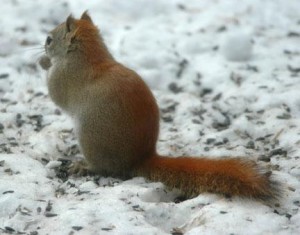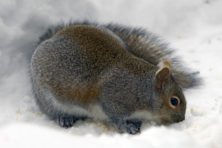The Red Squirrel
- Share
- Tweet
- Pin
- Share
The official proprietors of our outdoor bird-feeding area and brush piles have attained their true color. All summer these pugnacious, loquacious, sassy, soliloquizing pirates were quite brown. Now the red fur of these impudent little Red Squirrels marks them well. Their seasonal change of pelage (fur coat) is due to the actual replacement twice a year of the hairs of the body. The process is very gradual.
The winter pelage will be thicker, longer, softer and redder than that of summer, and the soles of their feet are heavily furred with the exception of the tubercles at the base of the toes. Soles in summer are naked. Even the ears have longer tufts of black hairs in winter compared to shorter red hairs during the warmer months. The creature’s winter tail, a most essential asset, is bushier than in summer. Naturally it will serve this fearless urchin as a warm shawl during the coldest season of the year. It will also aid him in balancing, as somewhat of a parachute when leaping or in the case of a fall, and especially as a device with which to express emotion. I personally believe it was the forerunner of the semaphore.
The three-inch-long black lateral line on the lower side of the body, generally separating the darker back from the whitish belly in summer, is now concealed by the longer outer guard hairs. Abbot H. Thayer, important art teacher of Louis Agassiz Fuertes, famous U.S. wildlife artist, labeled the coloration of many wild mammals, birds, and fish as complete obliterative shading. Viewed from above, the Red Squirrel blends in perfectly with tree limbs, bark, the forest floor, or even a stone wall. Viewed from below, the white or light gray outsides render the animal inconspicuous by the broken sky pattern of the forest roof.
Their autumnal molt begins in early November and is completed by late December or earlier. Now the broad rufous or rusty dorsal band down his back is more distinct and Mr. Red truly lives up to its name. Native Americans from various parts of this roguish little mammal’s very wide range named him Meeko, Ad-jee-dah-moe, Klee-ay, Kee-hah-chah, Zee-cha, Gid-a-mon and Zee-sin-ko. Eskimos called him Ki-gu-ik. The White Man nicknamed him Chickaree, Boomer, or Chatterbox, among other unprintable names.
I’m convinced that your earliest experiences with them play an important part in your admiration, or lack of it, for them, even though it can be very difficult to judge their true character. To some, Meeko is loaded with interest, initiative, and feistiness. Others find it a thieving tyrant, impulsive, impudent and a general nuisance. Friends of ours who have had problems with Meeko and his tribe getting into their attic and making a mess would be happy to see them magically disappear and never return.
Ernest Thompson Seton, one of my favorite nature writers and naturalists of years ago, made the claim that, “The rodents are very low in the scale of intelligence, but the Red Squirrel ranks high in its class. It is gifted with a burning curiosity, which, tempered by prudence and aided by agility, is an excellent start on the road to knowledge.”
At least a half dozen Gray Squirrels and two Red Squirrels occupy our south woods and feed daily in our front yard on whatever has been scattered or has fallen to the ground from the “squirrel-proof” feeders above. Meeko resents competition on his home grounds which may amount to around 500 – 700 yards across. The Gray Squirrel is nothing more than a trespasser in Red’s home feeding territory, and skirmishes between the two are nearly non-stop with Red usually being the winner.
Meeko’s staccato, scolding voice carries well and is often mixed with spits, sputters and growls and also accompanied with rapid foot pattering or stamping. At times he appears to literally boil with rage. Watching Red produce his chattering monologue, one wonders whether he could be as vocal minus a tail. It moves about as rapidly and with as many inflections as do the squirrel’s vocal cords!
The 500 White Spruces we planted on our property in the spring of 1978, primarily to serve as a windbreak to drift the snow and prevent it from piling up on our driveway, produces a bumper crop of cones every three or four years. The seeds of these cones, being one of the prime winter foods of Red Squirrels, are what lures and keeps at least one pair of them here every year. A few winters ago I was sawing some firewood (Ironwood) right next to the largest planting of White Spruces and was amazed at the size of several piles of cone scales, indicating where one of the “dining room tables” of a pair of Red Squirrels was located. A few of those so-called middens of scales and cones must have been over a foot deep and six or more feet wide.
H.H.T. Jackson, in his excellent Mammals of Wisconsin book, has a long and fascinating essay about the Red Squirrel, a mammal that is very familiar to many Door County people. He makes mention of how rare it is to come upon either a black or white Red Squirrel, and that in his many years of studying mammals he never did see an entirely black, or melanistic, Red Squirrel. Black Gray Squirrels are fairly common and have been seen by quite a few people in Door County.
It was in early January a few years ago that Charlotte and I went to see and photograph our first incredibly beautiful completely black Red Squirrel. Even its otherwise whitish belly was solid black. Having promised to not share the exact location of the gorgeous little mammal, other than that it lives in predominantly coniferous woods, fairly close to Lake Michigan, between Baileys Harbor and Sand Bay to the north. I’m sorry to say that you may have to wait another 40+ years, as I did, before experiencing one of these seldom-seen creatures. This rare little “Blackie” has been coming daily to a glass-jar sunflower seed feeder. I wish you good luck in locating a melanistic wild animal, especially a pitch-black Red Squirrel. Should you be so fortunate, I think you’ll agree with us that a black Red Squirrel is one of the most stunningly beautiful wild mammals one could ever expect to encounter in nature.





